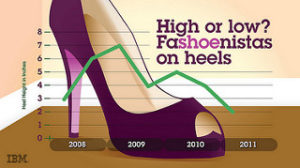From lipstick to ties, people have long considered fashion items as indicators for the economic climate. According to researchers at IBM, the height of high heels is another economic indicator that has a correlation to economic health.
A team of researchers at IBM led by consumer product expert Trevor Davis used social media sites and blog posts to find that the popularity of flats and low-heeled shoes is a possible sign that the economy is growing, whereas higher heels indicate the opposite. According to an IBM report, low-heeled flapper shoes in the 1920s were replaced with high-heel pumps and platforms during the Great Depression. Although low-heeled sandals were big in the late 1960s, platforms came back again during the 1970s oil crisis. More recently, the median height of women’s heels peaked at seven inches in 2009 during the recession, and then dropped to two inches by 2011 as the economy recovers.
Davis suggests that the reason women turn to higher heels during economic downturns is that more flamboyant fashions serve as a means to escape the harsh reality. There are, of course, other possible explanations for women’s preference of lower heel heights. Women may simply be embracing a more pain-free walking experience, or the natural cycle of fashion trends sometimes happens to coincide with the economic cycle. However, there is still a great possibility that low heels may actually indicate longer-term economic.

Leave a Reply
You must be logged in to post a comment.